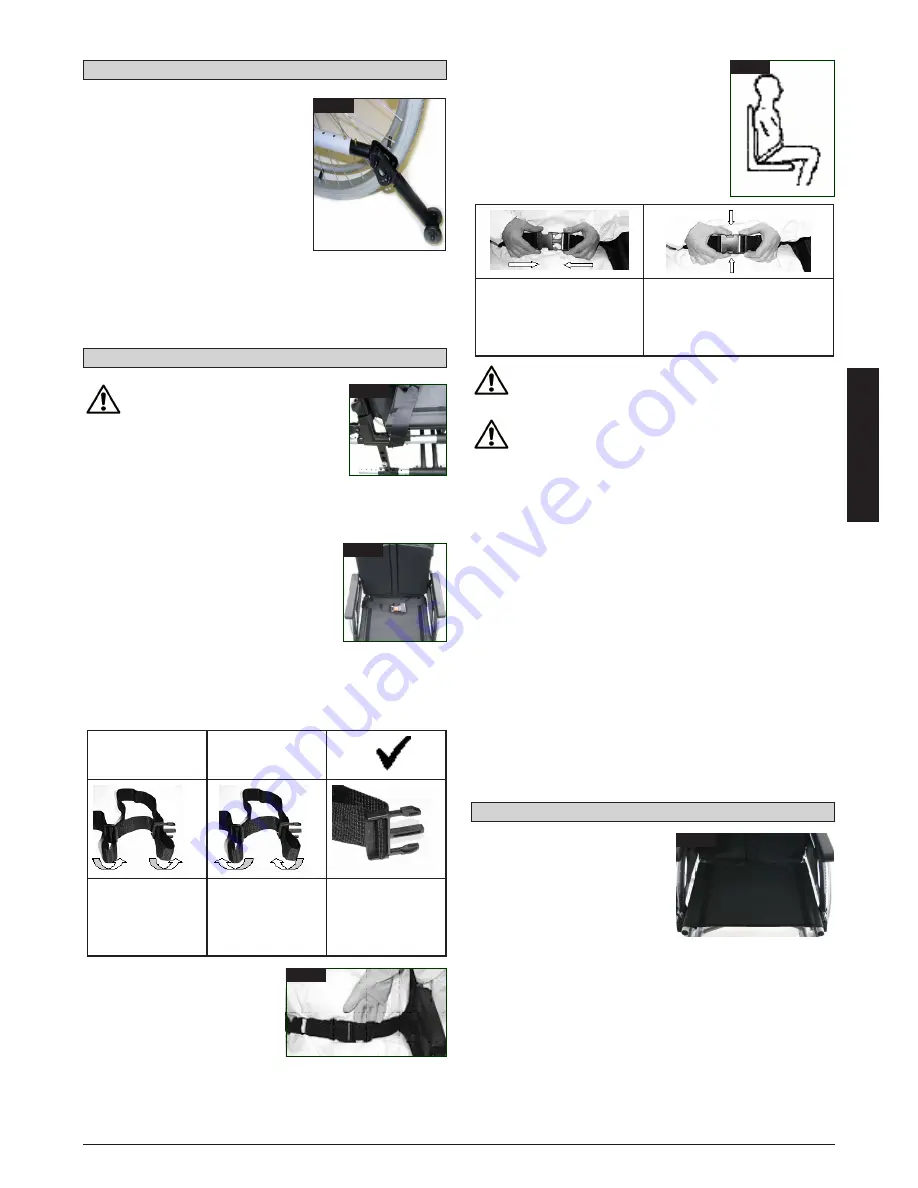
Anti-Tip Tubes
Anti-tip tubes provide additional safety
for inexperienced users when they are
still learning how to operate their
wheelchair. They prevent a wheelchair
from tipping over backwards.
By pushing on the release button, the
safety wheels can be set upwards or
removed. There must always be a gap of
between 3 cm and 5 cm between the
tube and the ground.
You must swing the safety wheels upwards when going up and
down large obstacles (such as a kerb) to prevent them from
touching the ground. Then rotate the safety wheels back down to the
normal position (Fig. 34).
ENGLISH
BasiX, RubiX, RubiX XL Rev. 2
12
0806/1/ST-000690646.EMS
Options - Seat
Standard seat sling
The sling is equipped with a Velcro
fastener on one side, this permits
stepless adjustment of the sling. To
adjust the sling, fold the chair up.
Then pull the front cover caps
forwards out of the frame. The sling
can be pulled off the frame. Undo
the Velcro fastener and adjust the
sling. Reverse this procedure to refit the sling (Fig. 39)
CAUTION:
For proper safety, at least 50 % of the Velcro surfaces must be
in contact with each other at all times.
CAUTION:
The sling must not be pulled too tight, as otherwise this could
interfere with the folding mechanism of the chair.
Comfort seat
The comfort seat permits comfortable long seating due to
the wooden base and the anatomically shaped cushion.
Options – Anti-Tip Tubes
Before using your wheelchair
ensure the lap belt is worn.
The lap belt must be checked on
a daily basis to ensure it is free
from any obstruction or adverse
wear.
Always make sure that the lap belt
is correctly secured and adjsuted
prior to use. Too loose a strap could cause the user to
slip down and risk suffocation or cause serious inju-
ry.
The lap belt is fitted to the wheelchair as
shown in the illustrations. The seat belt
comprises 2 halves. They are fitted using the
existing seat stay retaining bolt fitted through
the eyelet on the belt. The belt is routed
under the rear of the side panel. (Fig. 35)
Adjust the belt position so buckles are in the centre of the seat.
(Fig. 36)
Adjust lap belt to suit the user’s needs as follows:
To increase the belt
length
To reduce the belt
lenght
Feed free belt
through slide adjust-
ers and male buckle
to provide more belt
length.
Feed free belt back
through male buckle
and slide adjusters.
Ensure belt is not
looped at male
buckle.
When fastened check space
between the lap belt and user,
when correctly adjusted it should
not be possible to insert more than
the flat of the hand between the
lap belt and the user. (Fig. 37)
Fig. 37
Fig. 38
Options – Lap belt
To fasten buckle:
Firmly push male buckle into
female buckle.
To release belt:
Press exposed sides of male
buckle and push towards centre
whilst gently pulling apart.
If in doubt about the use and operation of the
lap belt then ask your healthcare professional,
wheelchair dealer, carer or attendant for assistance.
Do not rely on the lap belt only when the wheelchair
and occupant are transported in a vehicle. Use the
separate occupant lap and diagonal restraints
provided in the vehicle. See section transportation for
more details.
Fig. 34
Fig. 35
Fig. 36
Fig. 39
Advice to client
The lap belt must only be fitted by an approved Sunrise Medical
dealer / agent. The lap belt should only be adjusted by a
professional, or a Sunrise Medical approved dealer / agent.
The lap belt must be checked on a daily basis to ensure they are
adjusted correctly and are free from any obstruction or adverse
wear.
Sunrise Medical does not encourage the transportation of any
person in a vehicle using this lap belt as a method of restraint.
Please see Sunrise Medical transit booklet for further advice on
transportation.
Maintenance:
Check lap belt, and securing components, at regular intervals for
any sign of frays, or damage. Replace if necessary.
NOTE:
The lap belt should be adjusted to suit the end user as detailed
above. Sunrise Medical recommend that the length and fit of the belt
be checked on a regular basis to reduce the risk of the end user
inadvertently re-adjusting the belt to an excessive length.
The lap belt should be fixed so that the belt
sits at an angle of 45 degrees across the users
pelvis. The user should be upright and be as
far back as possible in the seat when correctly
adjusted. The lap belt should not allow the user
to slip down in the seat.
(Fig. 38)





































